BX2081: Consumer Decision Making Processes for Apple Inc. iPhones
VerifiedAdded on 2022/11/15
|10
|4043
|59
Report
AI Summary
This report provides a comprehensive analysis of consumer decision-making processes within Apple Inc., specifically focusing on the iPhone. It begins by examining the purchase situation and profiles the target market, considering demographic, psychographic, and behavioral variables. The report then delves into the factors that influence consumer decision-making, including social, personal, and psychological influences, as well as the stages of the consumer decision-making process. Furthermore, it explores internal influences, such as motivation and Maslow's hierarchy of needs. The report also includes the consumer decision making process and discusses the application of this information in developing or modifying marketing strategies. The report emphasizes the importance of understanding consumer behavior to effectively design, develop, and sell products and services. The paper concludes by emphasizing the significance of consumer loyalty and the various factors that contribute to it, as well as the post-purchase processes of consumers. This report offers insights into how Apple can maintain its market position and adapt to evolving consumer preferences.
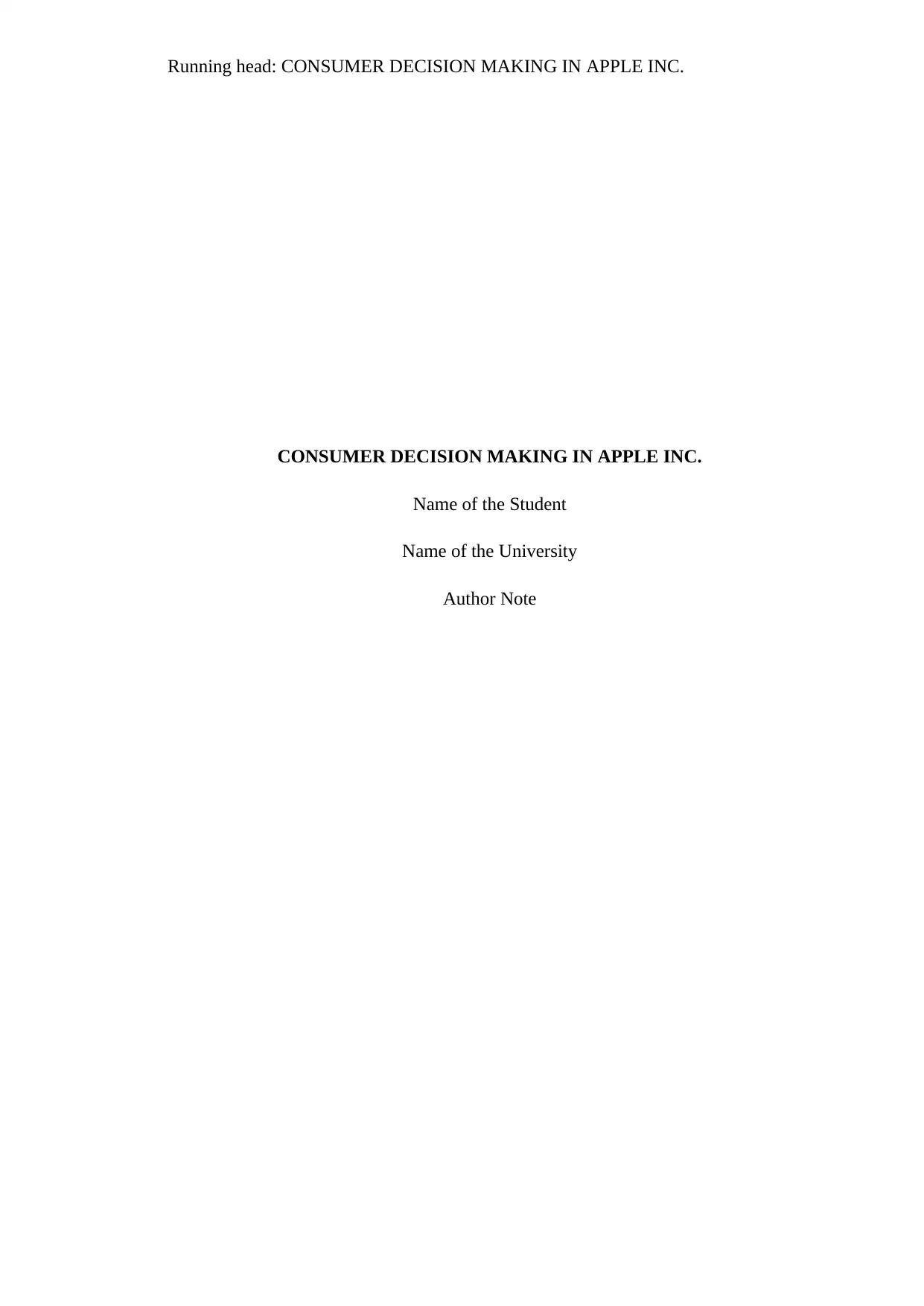
Running head: CONSUMER DECISION MAKING IN APPLE INC.
CONSUMER DECISION MAKING IN APPLE INC.
Name of the Student
Name of the University
Author Note
CONSUMER DECISION MAKING IN APPLE INC.
Name of the Student
Name of the University
Author Note
Paraphrase This Document
Need a fresh take? Get an instant paraphrase of this document with our AI Paraphraser
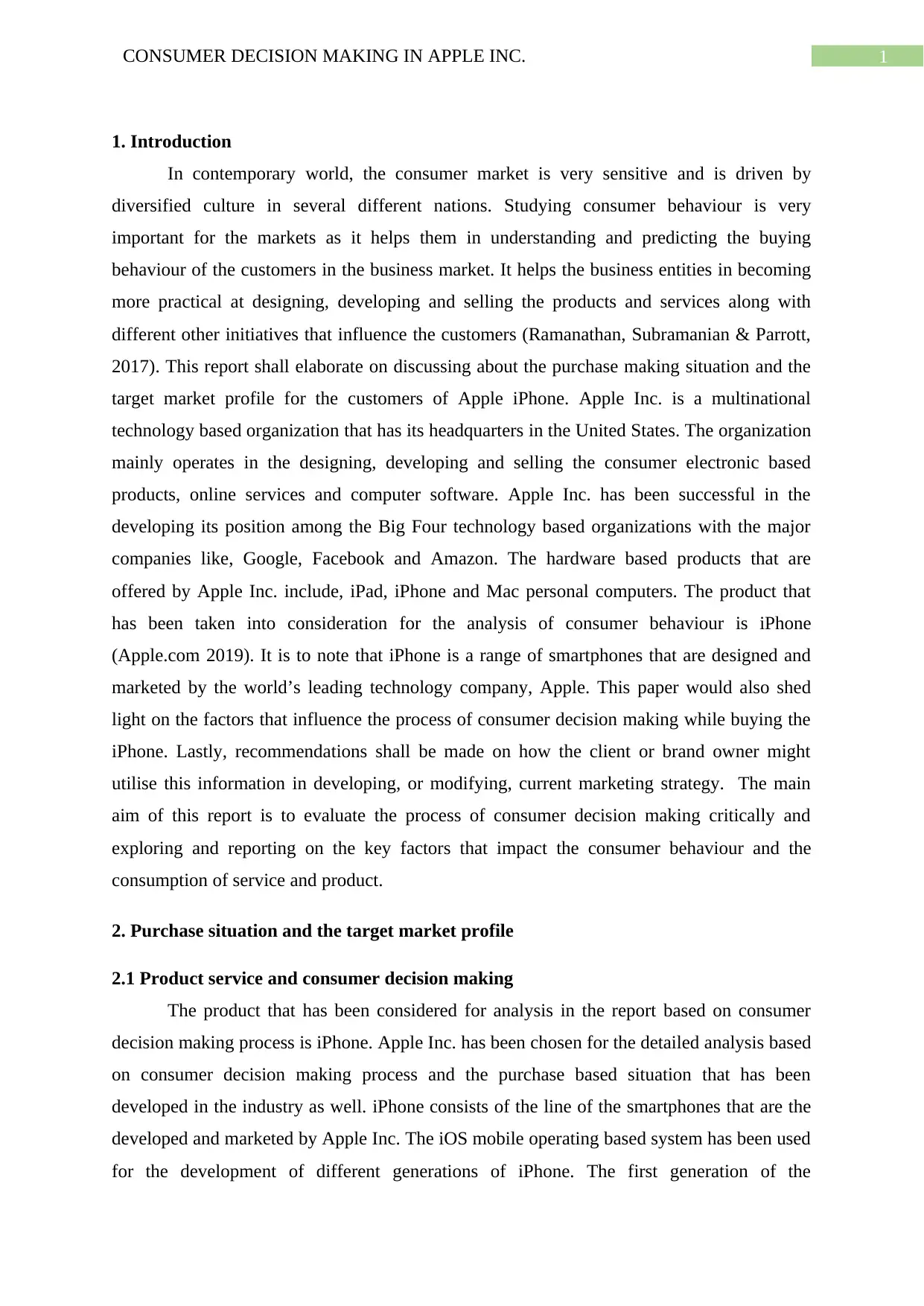
1CONSUMER DECISION MAKING IN APPLE INC.
1. Introduction
In contemporary world, the consumer market is very sensitive and is driven by
diversified culture in several different nations. Studying consumer behaviour is very
important for the markets as it helps them in understanding and predicting the buying
behaviour of the customers in the business market. It helps the business entities in becoming
more practical at designing, developing and selling the products and services along with
different other initiatives that influence the customers (Ramanathan, Subramanian & Parrott,
2017). This report shall elaborate on discussing about the purchase making situation and the
target market profile for the customers of Apple iPhone. Apple Inc. is a multinational
technology based organization that has its headquarters in the United States. The organization
mainly operates in the designing, developing and selling the consumer electronic based
products, online services and computer software. Apple Inc. has been successful in the
developing its position among the Big Four technology based organizations with the major
companies like, Google, Facebook and Amazon. The hardware based products that are
offered by Apple Inc. include, iPad, iPhone and Mac personal computers. The product that
has been taken into consideration for the analysis of consumer behaviour is iPhone
(Apple.com 2019). It is to note that iPhone is a range of smartphones that are designed and
marketed by the world’s leading technology company, Apple. This paper would also shed
light on the factors that influence the process of consumer decision making while buying the
iPhone. Lastly, recommendations shall be made on how the client or brand owner might
utilise this information in developing, or modifying, current marketing strategy. The main
aim of this report is to evaluate the process of consumer decision making critically and
exploring and reporting on the key factors that impact the consumer behaviour and the
consumption of service and product.
2. Purchase situation and the target market profile
2.1 Product service and consumer decision making
The product that has been considered for analysis in the report based on consumer
decision making process is iPhone. Apple Inc. has been chosen for the detailed analysis based
on consumer decision making process and the purchase based situation that has been
developed in the industry as well. iPhone consists of the line of the smartphones that are the
developed and marketed by Apple Inc. The iOS mobile operating based system has been used
for the development of different generations of iPhone. The first generation of the
1. Introduction
In contemporary world, the consumer market is very sensitive and is driven by
diversified culture in several different nations. Studying consumer behaviour is very
important for the markets as it helps them in understanding and predicting the buying
behaviour of the customers in the business market. It helps the business entities in becoming
more practical at designing, developing and selling the products and services along with
different other initiatives that influence the customers (Ramanathan, Subramanian & Parrott,
2017). This report shall elaborate on discussing about the purchase making situation and the
target market profile for the customers of Apple iPhone. Apple Inc. is a multinational
technology based organization that has its headquarters in the United States. The organization
mainly operates in the designing, developing and selling the consumer electronic based
products, online services and computer software. Apple Inc. has been successful in the
developing its position among the Big Four technology based organizations with the major
companies like, Google, Facebook and Amazon. The hardware based products that are
offered by Apple Inc. include, iPad, iPhone and Mac personal computers. The product that
has been taken into consideration for the analysis of consumer behaviour is iPhone
(Apple.com 2019). It is to note that iPhone is a range of smartphones that are designed and
marketed by the world’s leading technology company, Apple. This paper would also shed
light on the factors that influence the process of consumer decision making while buying the
iPhone. Lastly, recommendations shall be made on how the client or brand owner might
utilise this information in developing, or modifying, current marketing strategy. The main
aim of this report is to evaluate the process of consumer decision making critically and
exploring and reporting on the key factors that impact the consumer behaviour and the
consumption of service and product.
2. Purchase situation and the target market profile
2.1 Product service and consumer decision making
The product that has been considered for analysis in the report based on consumer
decision making process is iPhone. Apple Inc. has been chosen for the detailed analysis based
on consumer decision making process and the purchase based situation that has been
developed in the industry as well. iPhone consists of the line of the smartphones that are the
developed and marketed by Apple Inc. The iOS mobile operating based system has been used
for the development of different generations of iPhone. The first generation of the
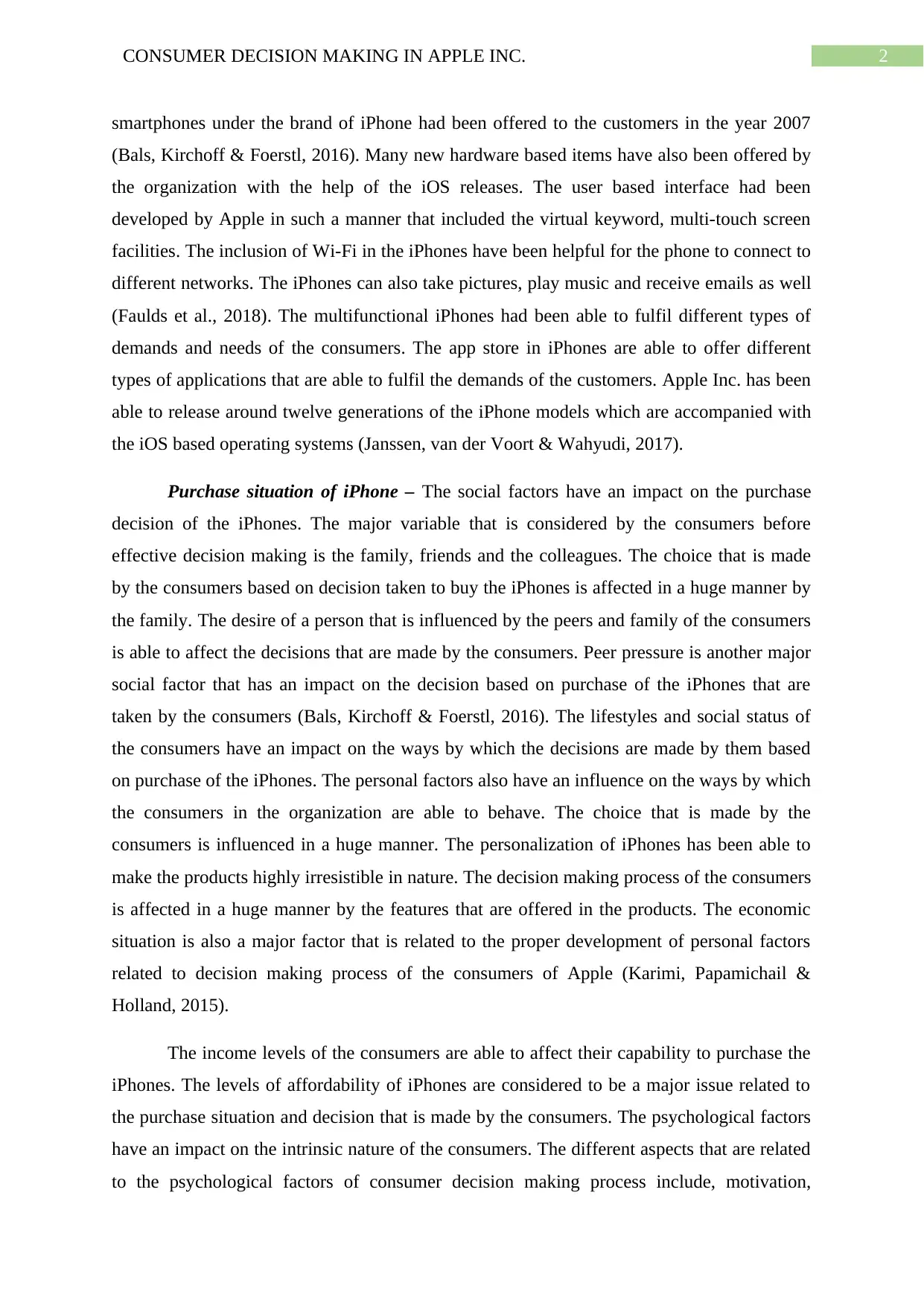
2CONSUMER DECISION MAKING IN APPLE INC.
smartphones under the brand of iPhone had been offered to the customers in the year 2007
(Bals, Kirchoff & Foerstl, 2016). Many new hardware based items have also been offered by
the organization with the help of the iOS releases. The user based interface had been
developed by Apple in such a manner that included the virtual keyword, multi-touch screen
facilities. The inclusion of Wi-Fi in the iPhones have been helpful for the phone to connect to
different networks. The iPhones can also take pictures, play music and receive emails as well
(Faulds et al., 2018). The multifunctional iPhones had been able to fulfil different types of
demands and needs of the consumers. The app store in iPhones are able to offer different
types of applications that are able to fulfil the demands of the customers. Apple Inc. has been
able to release around twelve generations of the iPhone models which are accompanied with
the iOS based operating systems (Janssen, van der Voort & Wahyudi, 2017).
Purchase situation of iPhone – The social factors have an impact on the purchase
decision of the iPhones. The major variable that is considered by the consumers before
effective decision making is the family, friends and the colleagues. The choice that is made
by the consumers based on decision taken to buy the iPhones is affected in a huge manner by
the family. The desire of a person that is influenced by the peers and family of the consumers
is able to affect the decisions that are made by the consumers. Peer pressure is another major
social factor that has an impact on the decision based on purchase of the iPhones that are
taken by the consumers (Bals, Kirchoff & Foerstl, 2016). The lifestyles and social status of
the consumers have an impact on the ways by which the decisions are made by them based
on purchase of the iPhones. The personal factors also have an influence on the ways by which
the consumers in the organization are able to behave. The choice that is made by the
consumers is influenced in a huge manner. The personalization of iPhones has been able to
make the products highly irresistible in nature. The decision making process of the consumers
is affected in a huge manner by the features that are offered in the products. The economic
situation is also a major factor that is related to the proper development of personal factors
related to decision making process of the consumers of Apple (Karimi, Papamichail &
Holland, 2015).
The income levels of the consumers are able to affect their capability to purchase the
iPhones. The levels of affordability of iPhones are considered to be a major issue related to
the purchase situation and decision that is made by the consumers. The psychological factors
have an impact on the intrinsic nature of the consumers. The different aspects that are related
to the psychological factors of consumer decision making process include, motivation,
smartphones under the brand of iPhone had been offered to the customers in the year 2007
(Bals, Kirchoff & Foerstl, 2016). Many new hardware based items have also been offered by
the organization with the help of the iOS releases. The user based interface had been
developed by Apple in such a manner that included the virtual keyword, multi-touch screen
facilities. The inclusion of Wi-Fi in the iPhones have been helpful for the phone to connect to
different networks. The iPhones can also take pictures, play music and receive emails as well
(Faulds et al., 2018). The multifunctional iPhones had been able to fulfil different types of
demands and needs of the consumers. The app store in iPhones are able to offer different
types of applications that are able to fulfil the demands of the customers. Apple Inc. has been
able to release around twelve generations of the iPhone models which are accompanied with
the iOS based operating systems (Janssen, van der Voort & Wahyudi, 2017).
Purchase situation of iPhone – The social factors have an impact on the purchase
decision of the iPhones. The major variable that is considered by the consumers before
effective decision making is the family, friends and the colleagues. The choice that is made
by the consumers based on decision taken to buy the iPhones is affected in a huge manner by
the family. The desire of a person that is influenced by the peers and family of the consumers
is able to affect the decisions that are made by the consumers. Peer pressure is another major
social factor that has an impact on the decision based on purchase of the iPhones that are
taken by the consumers (Bals, Kirchoff & Foerstl, 2016). The lifestyles and social status of
the consumers have an impact on the ways by which the decisions are made by them based
on purchase of the iPhones. The personal factors also have an influence on the ways by which
the consumers in the organization are able to behave. The choice that is made by the
consumers is influenced in a huge manner. The personalization of iPhones has been able to
make the products highly irresistible in nature. The decision making process of the consumers
is affected in a huge manner by the features that are offered in the products. The economic
situation is also a major factor that is related to the proper development of personal factors
related to decision making process of the consumers of Apple (Karimi, Papamichail &
Holland, 2015).
The income levels of the consumers are able to affect their capability to purchase the
iPhones. The levels of affordability of iPhones are considered to be a major issue related to
the purchase situation and decision that is made by the consumers. The psychological factors
have an impact on the intrinsic nature of the consumers. The different aspects that are related
to the psychological factors of consumer decision making process include, motivation,
⊘ This is a preview!⊘
Do you want full access?
Subscribe today to unlock all pages.

Trusted by 1+ million students worldwide
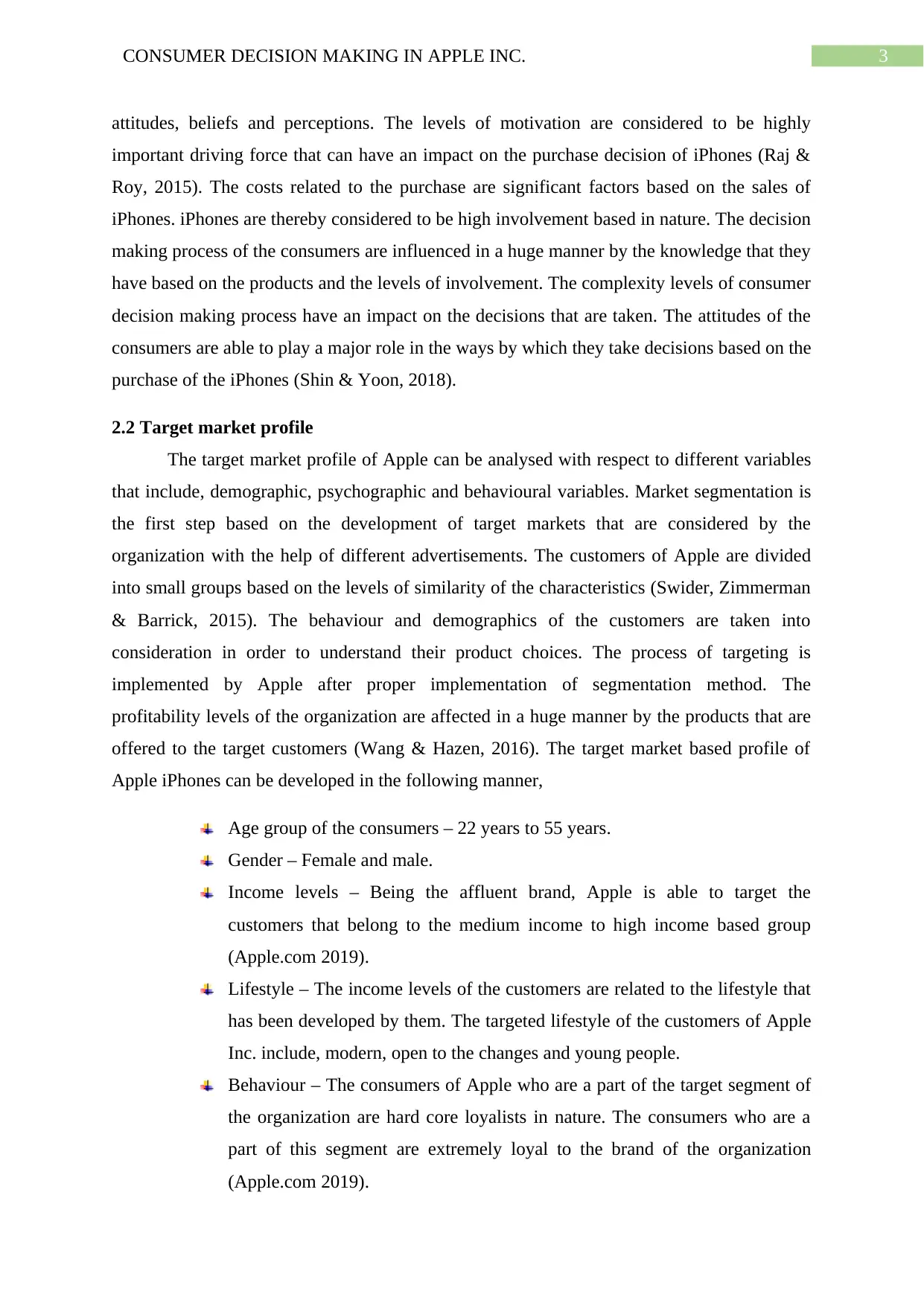
3CONSUMER DECISION MAKING IN APPLE INC.
attitudes, beliefs and perceptions. The levels of motivation are considered to be highly
important driving force that can have an impact on the purchase decision of iPhones (Raj &
Roy, 2015). The costs related to the purchase are significant factors based on the sales of
iPhones. iPhones are thereby considered to be high involvement based in nature. The decision
making process of the consumers are influenced in a huge manner by the knowledge that they
have based on the products and the levels of involvement. The complexity levels of consumer
decision making process have an impact on the decisions that are taken. The attitudes of the
consumers are able to play a major role in the ways by which they take decisions based on the
purchase of the iPhones (Shin & Yoon, 2018).
2.2 Target market profile
The target market profile of Apple can be analysed with respect to different variables
that include, demographic, psychographic and behavioural variables. Market segmentation is
the first step based on the development of target markets that are considered by the
organization with the help of different advertisements. The customers of Apple are divided
into small groups based on the levels of similarity of the characteristics (Swider, Zimmerman
& Barrick, 2015). The behaviour and demographics of the customers are taken into
consideration in order to understand their product choices. The process of targeting is
implemented by Apple after proper implementation of segmentation method. The
profitability levels of the organization are affected in a huge manner by the products that are
offered to the target customers (Wang & Hazen, 2016). The target market based profile of
Apple iPhones can be developed in the following manner,
Age group of the consumers – 22 years to 55 years.
Gender – Female and male.
Income levels – Being the affluent brand, Apple is able to target the
customers that belong to the medium income to high income based group
(Apple.com 2019).
Lifestyle – The income levels of the customers are related to the lifestyle that
has been developed by them. The targeted lifestyle of the customers of Apple
Inc. include, modern, open to the changes and young people.
Behaviour – The consumers of Apple who are a part of the target segment of
the organization are hard core loyalists in nature. The consumers who are a
part of this segment are extremely loyal to the brand of the organization
(Apple.com 2019).
attitudes, beliefs and perceptions. The levels of motivation are considered to be highly
important driving force that can have an impact on the purchase decision of iPhones (Raj &
Roy, 2015). The costs related to the purchase are significant factors based on the sales of
iPhones. iPhones are thereby considered to be high involvement based in nature. The decision
making process of the consumers are influenced in a huge manner by the knowledge that they
have based on the products and the levels of involvement. The complexity levels of consumer
decision making process have an impact on the decisions that are taken. The attitudes of the
consumers are able to play a major role in the ways by which they take decisions based on the
purchase of the iPhones (Shin & Yoon, 2018).
2.2 Target market profile
The target market profile of Apple can be analysed with respect to different variables
that include, demographic, psychographic and behavioural variables. Market segmentation is
the first step based on the development of target markets that are considered by the
organization with the help of different advertisements. The customers of Apple are divided
into small groups based on the levels of similarity of the characteristics (Swider, Zimmerman
& Barrick, 2015). The behaviour and demographics of the customers are taken into
consideration in order to understand their product choices. The process of targeting is
implemented by Apple after proper implementation of segmentation method. The
profitability levels of the organization are affected in a huge manner by the products that are
offered to the target customers (Wang & Hazen, 2016). The target market based profile of
Apple iPhones can be developed in the following manner,
Age group of the consumers – 22 years to 55 years.
Gender – Female and male.
Income levels – Being the affluent brand, Apple is able to target the
customers that belong to the medium income to high income based group
(Apple.com 2019).
Lifestyle – The income levels of the customers are related to the lifestyle that
has been developed by them. The targeted lifestyle of the customers of Apple
Inc. include, modern, open to the changes and young people.
Behaviour – The consumers of Apple who are a part of the target segment of
the organization are hard core loyalists in nature. The consumers who are a
part of this segment are extremely loyal to the brand of the organization
(Apple.com 2019).
Paraphrase This Document
Need a fresh take? Get an instant paraphrase of this document with our AI Paraphraser
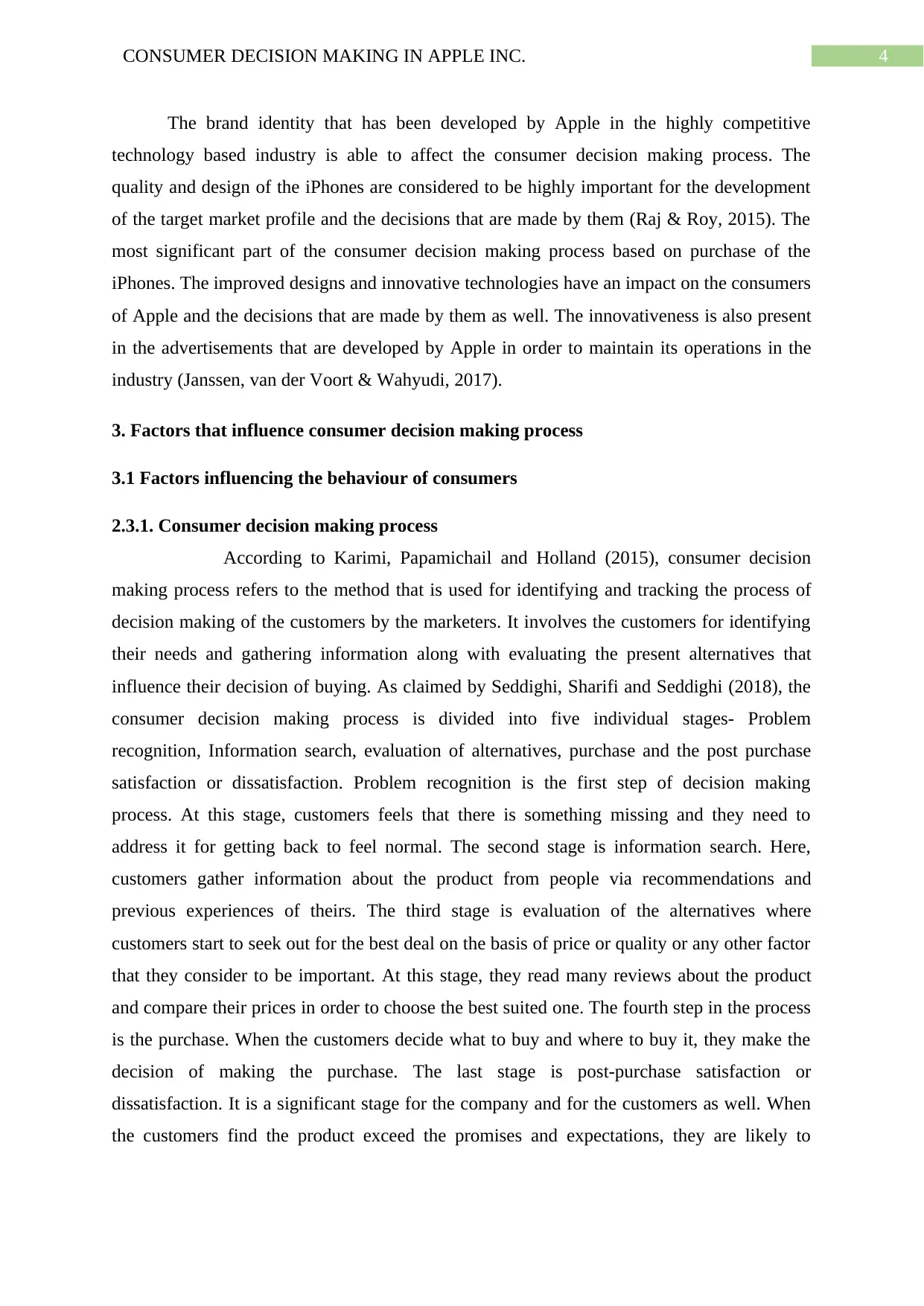
4CONSUMER DECISION MAKING IN APPLE INC.
The brand identity that has been developed by Apple in the highly competitive
technology based industry is able to affect the consumer decision making process. The
quality and design of the iPhones are considered to be highly important for the development
of the target market profile and the decisions that are made by them (Raj & Roy, 2015). The
most significant part of the consumer decision making process based on purchase of the
iPhones. The improved designs and innovative technologies have an impact on the consumers
of Apple and the decisions that are made by them as well. The innovativeness is also present
in the advertisements that are developed by Apple in order to maintain its operations in the
industry (Janssen, van der Voort & Wahyudi, 2017).
3. Factors that influence consumer decision making process
3.1 Factors influencing the behaviour of consumers
2.3.1. Consumer decision making process
According to Karimi, Papamichail and Holland (2015), consumer decision
making process refers to the method that is used for identifying and tracking the process of
decision making of the customers by the marketers. It involves the customers for identifying
their needs and gathering information along with evaluating the present alternatives that
influence their decision of buying. As claimed by Seddighi, Sharifi and Seddighi (2018), the
consumer decision making process is divided into five individual stages- Problem
recognition, Information search, evaluation of alternatives, purchase and the post purchase
satisfaction or dissatisfaction. Problem recognition is the first step of decision making
process. At this stage, customers feels that there is something missing and they need to
address it for getting back to feel normal. The second stage is information search. Here,
customers gather information about the product from people via recommendations and
previous experiences of theirs. The third stage is evaluation of the alternatives where
customers start to seek out for the best deal on the basis of price or quality or any other factor
that they consider to be important. At this stage, they read many reviews about the product
and compare their prices in order to choose the best suited one. The fourth step in the process
is the purchase. When the customers decide what to buy and where to buy it, they make the
decision of making the purchase. The last stage is post-purchase satisfaction or
dissatisfaction. It is a significant stage for the company and for the customers as well. When
the customers find the product exceed the promises and expectations, they are likely to
The brand identity that has been developed by Apple in the highly competitive
technology based industry is able to affect the consumer decision making process. The
quality and design of the iPhones are considered to be highly important for the development
of the target market profile and the decisions that are made by them (Raj & Roy, 2015). The
most significant part of the consumer decision making process based on purchase of the
iPhones. The improved designs and innovative technologies have an impact on the consumers
of Apple and the decisions that are made by them as well. The innovativeness is also present
in the advertisements that are developed by Apple in order to maintain its operations in the
industry (Janssen, van der Voort & Wahyudi, 2017).
3. Factors that influence consumer decision making process
3.1 Factors influencing the behaviour of consumers
2.3.1. Consumer decision making process
According to Karimi, Papamichail and Holland (2015), consumer decision
making process refers to the method that is used for identifying and tracking the process of
decision making of the customers by the marketers. It involves the customers for identifying
their needs and gathering information along with evaluating the present alternatives that
influence their decision of buying. As claimed by Seddighi, Sharifi and Seddighi (2018), the
consumer decision making process is divided into five individual stages- Problem
recognition, Information search, evaluation of alternatives, purchase and the post purchase
satisfaction or dissatisfaction. Problem recognition is the first step of decision making
process. At this stage, customers feels that there is something missing and they need to
address it for getting back to feel normal. The second stage is information search. Here,
customers gather information about the product from people via recommendations and
previous experiences of theirs. The third stage is evaluation of the alternatives where
customers start to seek out for the best deal on the basis of price or quality or any other factor
that they consider to be important. At this stage, they read many reviews about the product
and compare their prices in order to choose the best suited one. The fourth step in the process
is the purchase. When the customers decide what to buy and where to buy it, they make the
decision of making the purchase. The last stage is post-purchase satisfaction or
dissatisfaction. It is a significant stage for the company and for the customers as well. When
the customers find the product exceed the promises and expectations, they are likely to
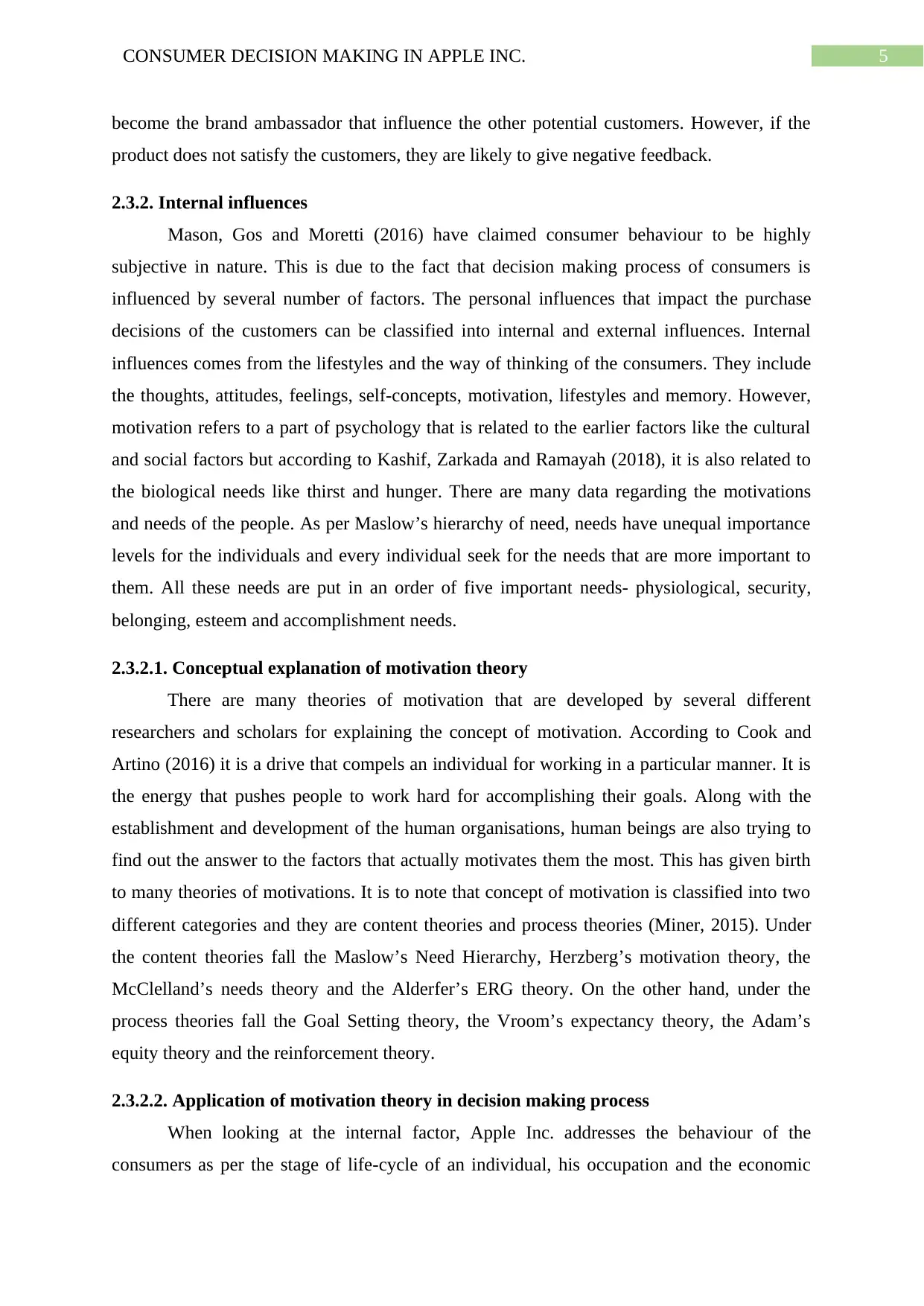
5CONSUMER DECISION MAKING IN APPLE INC.
become the brand ambassador that influence the other potential customers. However, if the
product does not satisfy the customers, they are likely to give negative feedback.
2.3.2. Internal influences
Mason, Gos and Moretti (2016) have claimed consumer behaviour to be highly
subjective in nature. This is due to the fact that decision making process of consumers is
influenced by several number of factors. The personal influences that impact the purchase
decisions of the customers can be classified into internal and external influences. Internal
influences comes from the lifestyles and the way of thinking of the consumers. They include
the thoughts, attitudes, feelings, self-concepts, motivation, lifestyles and memory. However,
motivation refers to a part of psychology that is related to the earlier factors like the cultural
and social factors but according to Kashif, Zarkada and Ramayah (2018), it is also related to
the biological needs like thirst and hunger. There are many data regarding the motivations
and needs of the people. As per Maslow’s hierarchy of need, needs have unequal importance
levels for the individuals and every individual seek for the needs that are more important to
them. All these needs are put in an order of five important needs- physiological, security,
belonging, esteem and accomplishment needs.
2.3.2.1. Conceptual explanation of motivation theory
There are many theories of motivation that are developed by several different
researchers and scholars for explaining the concept of motivation. According to Cook and
Artino (2016) it is a drive that compels an individual for working in a particular manner. It is
the energy that pushes people to work hard for accomplishing their goals. Along with the
establishment and development of the human organisations, human beings are also trying to
find out the answer to the factors that actually motivates them the most. This has given birth
to many theories of motivations. It is to note that concept of motivation is classified into two
different categories and they are content theories and process theories (Miner, 2015). Under
the content theories fall the Maslow’s Need Hierarchy, Herzberg’s motivation theory, the
McClelland’s needs theory and the Alderfer’s ERG theory. On the other hand, under the
process theories fall the Goal Setting theory, the Vroom’s expectancy theory, the Adam’s
equity theory and the reinforcement theory.
2.3.2.2. Application of motivation theory in decision making process
When looking at the internal factor, Apple Inc. addresses the behaviour of the
consumers as per the stage of life-cycle of an individual, his occupation and the economic
become the brand ambassador that influence the other potential customers. However, if the
product does not satisfy the customers, they are likely to give negative feedback.
2.3.2. Internal influences
Mason, Gos and Moretti (2016) have claimed consumer behaviour to be highly
subjective in nature. This is due to the fact that decision making process of consumers is
influenced by several number of factors. The personal influences that impact the purchase
decisions of the customers can be classified into internal and external influences. Internal
influences comes from the lifestyles and the way of thinking of the consumers. They include
the thoughts, attitudes, feelings, self-concepts, motivation, lifestyles and memory. However,
motivation refers to a part of psychology that is related to the earlier factors like the cultural
and social factors but according to Kashif, Zarkada and Ramayah (2018), it is also related to
the biological needs like thirst and hunger. There are many data regarding the motivations
and needs of the people. As per Maslow’s hierarchy of need, needs have unequal importance
levels for the individuals and every individual seek for the needs that are more important to
them. All these needs are put in an order of five important needs- physiological, security,
belonging, esteem and accomplishment needs.
2.3.2.1. Conceptual explanation of motivation theory
There are many theories of motivation that are developed by several different
researchers and scholars for explaining the concept of motivation. According to Cook and
Artino (2016) it is a drive that compels an individual for working in a particular manner. It is
the energy that pushes people to work hard for accomplishing their goals. Along with the
establishment and development of the human organisations, human beings are also trying to
find out the answer to the factors that actually motivates them the most. This has given birth
to many theories of motivations. It is to note that concept of motivation is classified into two
different categories and they are content theories and process theories (Miner, 2015). Under
the content theories fall the Maslow’s Need Hierarchy, Herzberg’s motivation theory, the
McClelland’s needs theory and the Alderfer’s ERG theory. On the other hand, under the
process theories fall the Goal Setting theory, the Vroom’s expectancy theory, the Adam’s
equity theory and the reinforcement theory.
2.3.2.2. Application of motivation theory in decision making process
When looking at the internal factor, Apple Inc. addresses the behaviour of the
consumers as per the stage of life-cycle of an individual, his occupation and the economic
⊘ This is a preview!⊘
Do you want full access?
Subscribe today to unlock all pages.

Trusted by 1+ million students worldwide
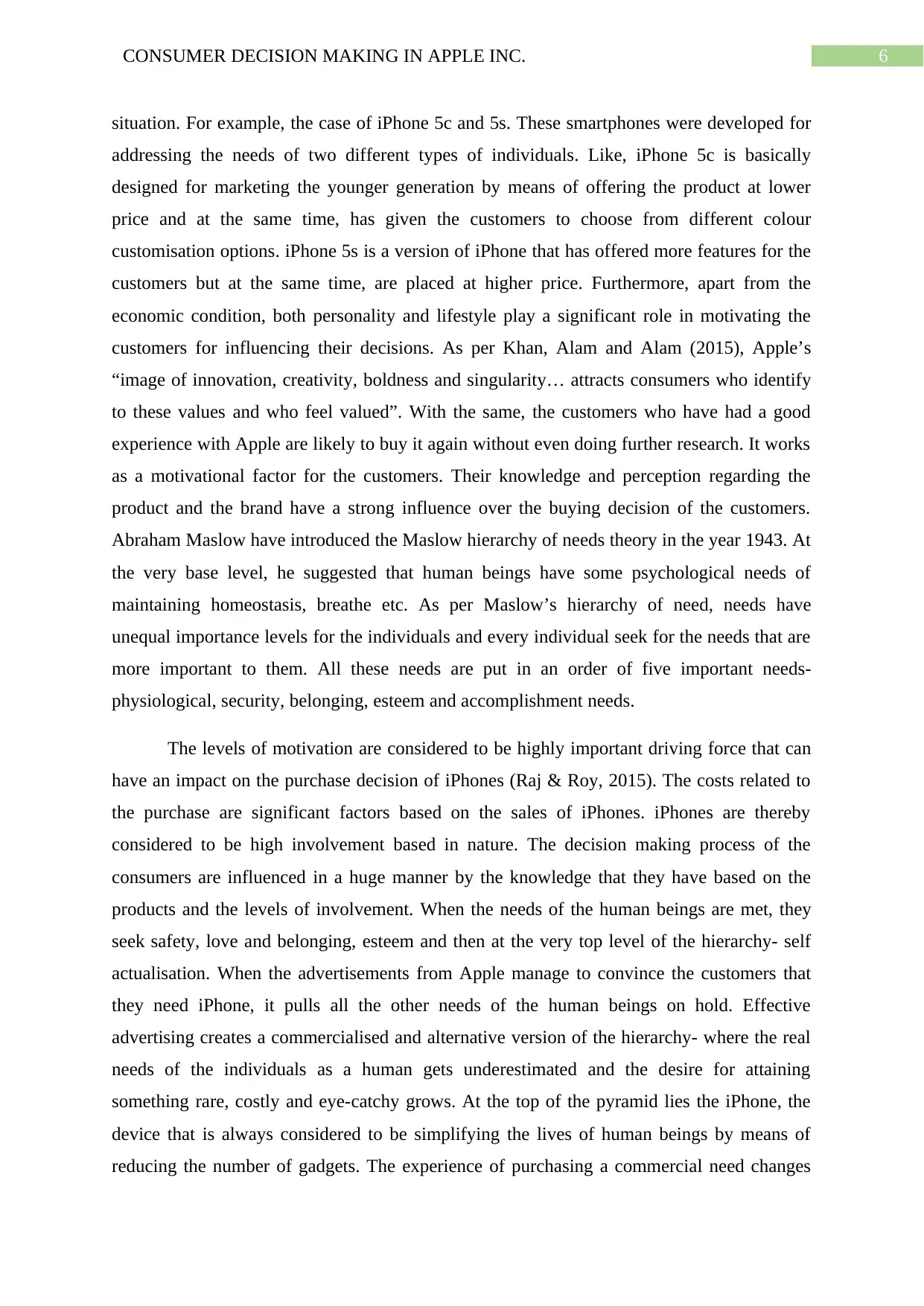
6CONSUMER DECISION MAKING IN APPLE INC.
situation. For example, the case of iPhone 5c and 5s. These smartphones were developed for
addressing the needs of two different types of individuals. Like, iPhone 5c is basically
designed for marketing the younger generation by means of offering the product at lower
price and at the same time, has given the customers to choose from different colour
customisation options. iPhone 5s is a version of iPhone that has offered more features for the
customers but at the same time, are placed at higher price. Furthermore, apart from the
economic condition, both personality and lifestyle play a significant role in motivating the
customers for influencing their decisions. As per Khan, Alam and Alam (2015), Apple’s
“image of innovation, creativity, boldness and singularity… attracts consumers who identify
to these values and who feel valued”. With the same, the customers who have had a good
experience with Apple are likely to buy it again without even doing further research. It works
as a motivational factor for the customers. Their knowledge and perception regarding the
product and the brand have a strong influence over the buying decision of the customers.
Abraham Maslow have introduced the Maslow hierarchy of needs theory in the year 1943. At
the very base level, he suggested that human beings have some psychological needs of
maintaining homeostasis, breathe etc. As per Maslow’s hierarchy of need, needs have
unequal importance levels for the individuals and every individual seek for the needs that are
more important to them. All these needs are put in an order of five important needs-
physiological, security, belonging, esteem and accomplishment needs.
The levels of motivation are considered to be highly important driving force that can
have an impact on the purchase decision of iPhones (Raj & Roy, 2015). The costs related to
the purchase are significant factors based on the sales of iPhones. iPhones are thereby
considered to be high involvement based in nature. The decision making process of the
consumers are influenced in a huge manner by the knowledge that they have based on the
products and the levels of involvement. When the needs of the human beings are met, they
seek safety, love and belonging, esteem and then at the very top level of the hierarchy- self
actualisation. When the advertisements from Apple manage to convince the customers that
they need iPhone, it pulls all the other needs of the human beings on hold. Effective
advertising creates a commercialised and alternative version of the hierarchy- where the real
needs of the individuals as a human gets underestimated and the desire for attaining
something rare, costly and eye-catchy grows. At the top of the pyramid lies the iPhone, the
device that is always considered to be simplifying the lives of human beings by means of
reducing the number of gadgets. The experience of purchasing a commercial need changes
situation. For example, the case of iPhone 5c and 5s. These smartphones were developed for
addressing the needs of two different types of individuals. Like, iPhone 5c is basically
designed for marketing the younger generation by means of offering the product at lower
price and at the same time, has given the customers to choose from different colour
customisation options. iPhone 5s is a version of iPhone that has offered more features for the
customers but at the same time, are placed at higher price. Furthermore, apart from the
economic condition, both personality and lifestyle play a significant role in motivating the
customers for influencing their decisions. As per Khan, Alam and Alam (2015), Apple’s
“image of innovation, creativity, boldness and singularity… attracts consumers who identify
to these values and who feel valued”. With the same, the customers who have had a good
experience with Apple are likely to buy it again without even doing further research. It works
as a motivational factor for the customers. Their knowledge and perception regarding the
product and the brand have a strong influence over the buying decision of the customers.
Abraham Maslow have introduced the Maslow hierarchy of needs theory in the year 1943. At
the very base level, he suggested that human beings have some psychological needs of
maintaining homeostasis, breathe etc. As per Maslow’s hierarchy of need, needs have
unequal importance levels for the individuals and every individual seek for the needs that are
more important to them. All these needs are put in an order of five important needs-
physiological, security, belonging, esteem and accomplishment needs.
The levels of motivation are considered to be highly important driving force that can
have an impact on the purchase decision of iPhones (Raj & Roy, 2015). The costs related to
the purchase are significant factors based on the sales of iPhones. iPhones are thereby
considered to be high involvement based in nature. The decision making process of the
consumers are influenced in a huge manner by the knowledge that they have based on the
products and the levels of involvement. When the needs of the human beings are met, they
seek safety, love and belonging, esteem and then at the very top level of the hierarchy- self
actualisation. When the advertisements from Apple manage to convince the customers that
they need iPhone, it pulls all the other needs of the human beings on hold. Effective
advertising creates a commercialised and alternative version of the hierarchy- where the real
needs of the individuals as a human gets underestimated and the desire for attaining
something rare, costly and eye-catchy grows. At the top of the pyramid lies the iPhone, the
device that is always considered to be simplifying the lives of human beings by means of
reducing the number of gadgets. The experience of purchasing a commercial need changes
Paraphrase This Document
Need a fresh take? Get an instant paraphrase of this document with our AI Paraphraser
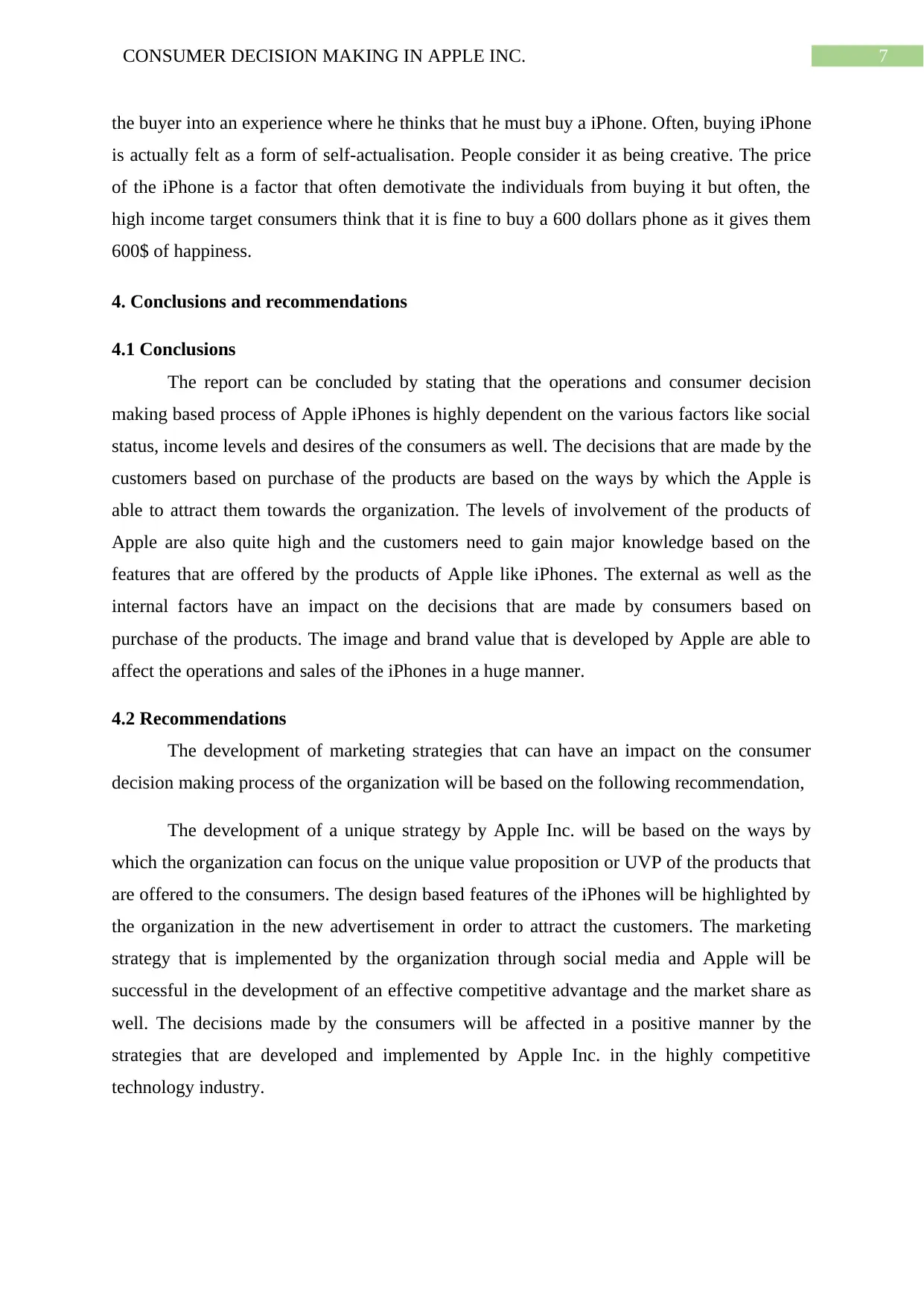
7CONSUMER DECISION MAKING IN APPLE INC.
the buyer into an experience where he thinks that he must buy a iPhone. Often, buying iPhone
is actually felt as a form of self-actualisation. People consider it as being creative. The price
of the iPhone is a factor that often demotivate the individuals from buying it but often, the
high income target consumers think that it is fine to buy a 600 dollars phone as it gives them
600$ of happiness.
4. Conclusions and recommendations
4.1 Conclusions
The report can be concluded by stating that the operations and consumer decision
making based process of Apple iPhones is highly dependent on the various factors like social
status, income levels and desires of the consumers as well. The decisions that are made by the
customers based on purchase of the products are based on the ways by which the Apple is
able to attract them towards the organization. The levels of involvement of the products of
Apple are also quite high and the customers need to gain major knowledge based on the
features that are offered by the products of Apple like iPhones. The external as well as the
internal factors have an impact on the decisions that are made by consumers based on
purchase of the products. The image and brand value that is developed by Apple are able to
affect the operations and sales of the iPhones in a huge manner.
4.2 Recommendations
The development of marketing strategies that can have an impact on the consumer
decision making process of the organization will be based on the following recommendation,
The development of a unique strategy by Apple Inc. will be based on the ways by
which the organization can focus on the unique value proposition or UVP of the products that
are offered to the consumers. The design based features of the iPhones will be highlighted by
the organization in the new advertisement in order to attract the customers. The marketing
strategy that is implemented by the organization through social media and Apple will be
successful in the development of an effective competitive advantage and the market share as
well. The decisions made by the consumers will be affected in a positive manner by the
strategies that are developed and implemented by Apple Inc. in the highly competitive
technology industry.
the buyer into an experience where he thinks that he must buy a iPhone. Often, buying iPhone
is actually felt as a form of self-actualisation. People consider it as being creative. The price
of the iPhone is a factor that often demotivate the individuals from buying it but often, the
high income target consumers think that it is fine to buy a 600 dollars phone as it gives them
600$ of happiness.
4. Conclusions and recommendations
4.1 Conclusions
The report can be concluded by stating that the operations and consumer decision
making based process of Apple iPhones is highly dependent on the various factors like social
status, income levels and desires of the consumers as well. The decisions that are made by the
customers based on purchase of the products are based on the ways by which the Apple is
able to attract them towards the organization. The levels of involvement of the products of
Apple are also quite high and the customers need to gain major knowledge based on the
features that are offered by the products of Apple like iPhones. The external as well as the
internal factors have an impact on the decisions that are made by consumers based on
purchase of the products. The image and brand value that is developed by Apple are able to
affect the operations and sales of the iPhones in a huge manner.
4.2 Recommendations
The development of marketing strategies that can have an impact on the consumer
decision making process of the organization will be based on the following recommendation,
The development of a unique strategy by Apple Inc. will be based on the ways by
which the organization can focus on the unique value proposition or UVP of the products that
are offered to the consumers. The design based features of the iPhones will be highlighted by
the organization in the new advertisement in order to attract the customers. The marketing
strategy that is implemented by the organization through social media and Apple will be
successful in the development of an effective competitive advantage and the market share as
well. The decisions made by the consumers will be affected in a positive manner by the
strategies that are developed and implemented by Apple Inc. in the highly competitive
technology industry.
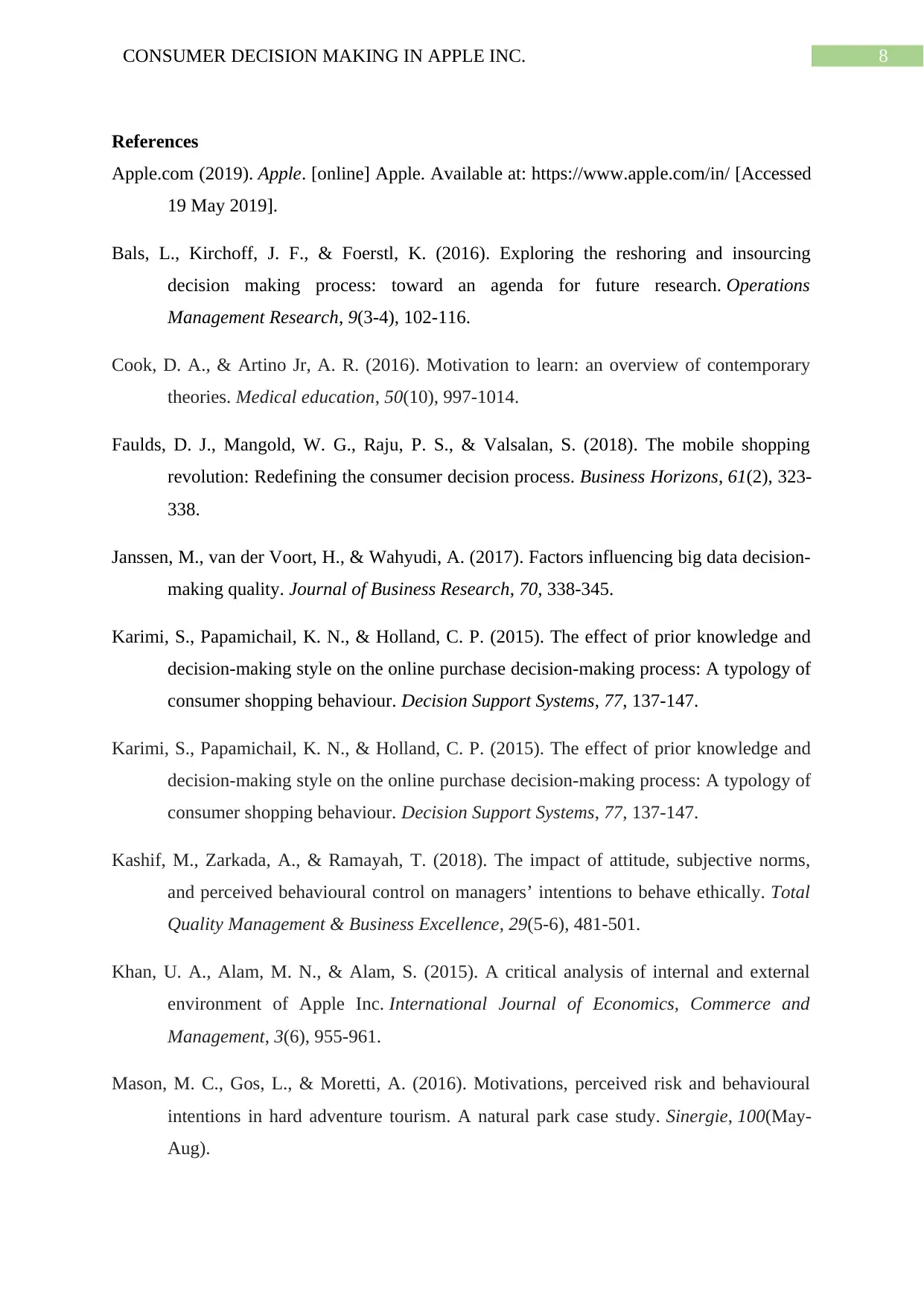
8CONSUMER DECISION MAKING IN APPLE INC.
References
Apple.com (2019). Apple. [online] Apple. Available at: https://www.apple.com/in/ [Accessed
19 May 2019].
Bals, L., Kirchoff, J. F., & Foerstl, K. (2016). Exploring the reshoring and insourcing
decision making process: toward an agenda for future research. Operations
Management Research, 9(3-4), 102-116.
Cook, D. A., & Artino Jr, A. R. (2016). Motivation to learn: an overview of contemporary
theories. Medical education, 50(10), 997-1014.
Faulds, D. J., Mangold, W. G., Raju, P. S., & Valsalan, S. (2018). The mobile shopping
revolution: Redefining the consumer decision process. Business Horizons, 61(2), 323-
338.
Janssen, M., van der Voort, H., & Wahyudi, A. (2017). Factors influencing big data decision-
making quality. Journal of Business Research, 70, 338-345.
Karimi, S., Papamichail, K. N., & Holland, C. P. (2015). The effect of prior knowledge and
decision-making style on the online purchase decision-making process: A typology of
consumer shopping behaviour. Decision Support Systems, 77, 137-147.
Karimi, S., Papamichail, K. N., & Holland, C. P. (2015). The effect of prior knowledge and
decision-making style on the online purchase decision-making process: A typology of
consumer shopping behaviour. Decision Support Systems, 77, 137-147.
Kashif, M., Zarkada, A., & Ramayah, T. (2018). The impact of attitude, subjective norms,
and perceived behavioural control on managers’ intentions to behave ethically. Total
Quality Management & Business Excellence, 29(5-6), 481-501.
Khan, U. A., Alam, M. N., & Alam, S. (2015). A critical analysis of internal and external
environment of Apple Inc. International Journal of Economics, Commerce and
Management, 3(6), 955-961.
Mason, M. C., Gos, L., & Moretti, A. (2016). Motivations, perceived risk and behavioural
intentions in hard adventure tourism. A natural park case study. Sinergie, 100(May-
Aug).
References
Apple.com (2019). Apple. [online] Apple. Available at: https://www.apple.com/in/ [Accessed
19 May 2019].
Bals, L., Kirchoff, J. F., & Foerstl, K. (2016). Exploring the reshoring and insourcing
decision making process: toward an agenda for future research. Operations
Management Research, 9(3-4), 102-116.
Cook, D. A., & Artino Jr, A. R. (2016). Motivation to learn: an overview of contemporary
theories. Medical education, 50(10), 997-1014.
Faulds, D. J., Mangold, W. G., Raju, P. S., & Valsalan, S. (2018). The mobile shopping
revolution: Redefining the consumer decision process. Business Horizons, 61(2), 323-
338.
Janssen, M., van der Voort, H., & Wahyudi, A. (2017). Factors influencing big data decision-
making quality. Journal of Business Research, 70, 338-345.
Karimi, S., Papamichail, K. N., & Holland, C. P. (2015). The effect of prior knowledge and
decision-making style on the online purchase decision-making process: A typology of
consumer shopping behaviour. Decision Support Systems, 77, 137-147.
Karimi, S., Papamichail, K. N., & Holland, C. P. (2015). The effect of prior knowledge and
decision-making style on the online purchase decision-making process: A typology of
consumer shopping behaviour. Decision Support Systems, 77, 137-147.
Kashif, M., Zarkada, A., & Ramayah, T. (2018). The impact of attitude, subjective norms,
and perceived behavioural control on managers’ intentions to behave ethically. Total
Quality Management & Business Excellence, 29(5-6), 481-501.
Khan, U. A., Alam, M. N., & Alam, S. (2015). A critical analysis of internal and external
environment of Apple Inc. International Journal of Economics, Commerce and
Management, 3(6), 955-961.
Mason, M. C., Gos, L., & Moretti, A. (2016). Motivations, perceived risk and behavioural
intentions in hard adventure tourism. A natural park case study. Sinergie, 100(May-
Aug).
⊘ This is a preview!⊘
Do you want full access?
Subscribe today to unlock all pages.

Trusted by 1+ million students worldwide
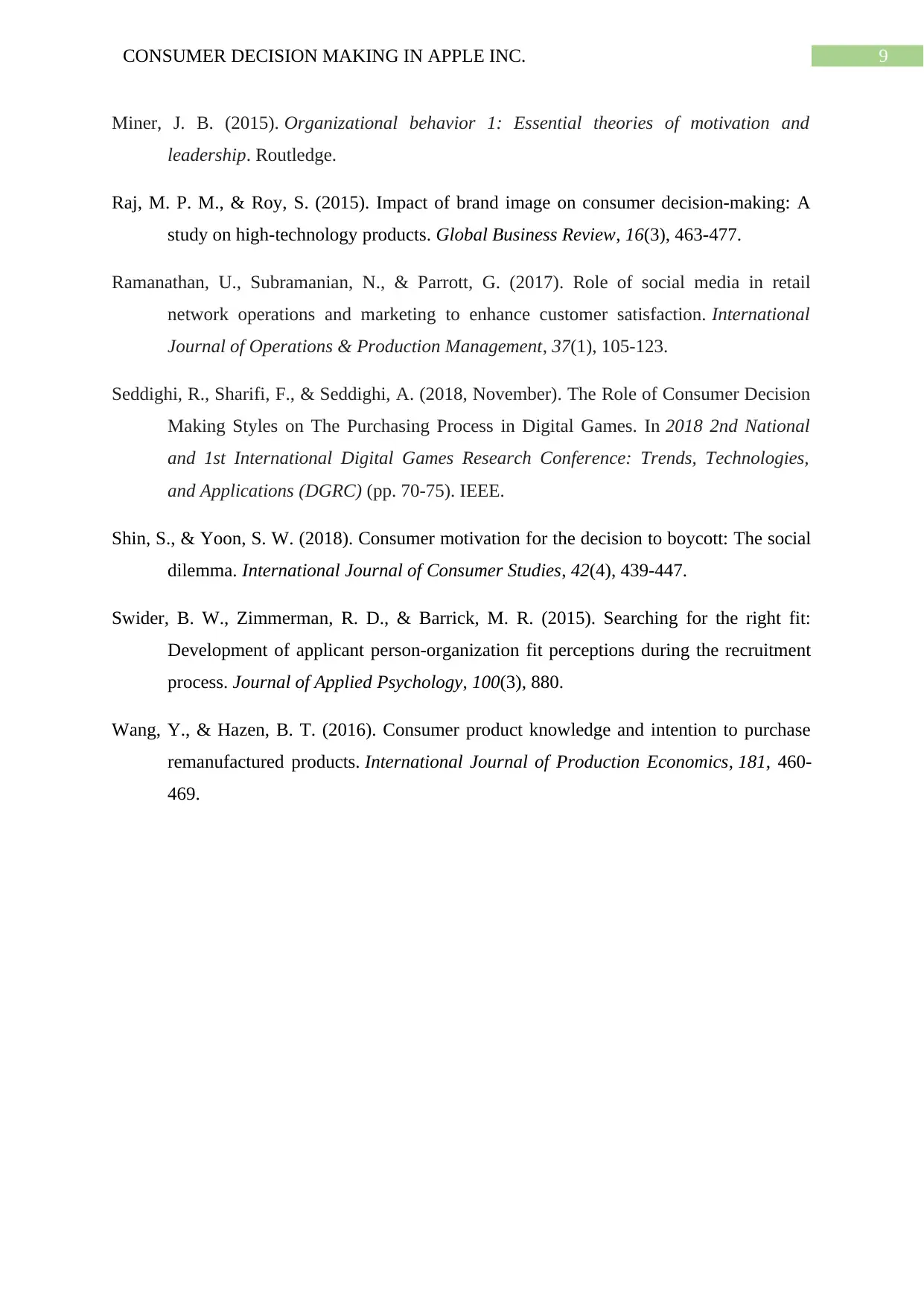
9CONSUMER DECISION MAKING IN APPLE INC.
Miner, J. B. (2015). Organizational behavior 1: Essential theories of motivation and
leadership. Routledge.
Raj, M. P. M., & Roy, S. (2015). Impact of brand image on consumer decision-making: A
study on high-technology products. Global Business Review, 16(3), 463-477.
Ramanathan, U., Subramanian, N., & Parrott, G. (2017). Role of social media in retail
network operations and marketing to enhance customer satisfaction. International
Journal of Operations & Production Management, 37(1), 105-123.
Seddighi, R., Sharifi, F., & Seddighi, A. (2018, November). The Role of Consumer Decision
Making Styles on The Purchasing Process in Digital Games. In 2018 2nd National
and 1st International Digital Games Research Conference: Trends, Technologies,
and Applications (DGRC) (pp. 70-75). IEEE.
Shin, S., & Yoon, S. W. (2018). Consumer motivation for the decision to boycott: The social
dilemma. International Journal of Consumer Studies, 42(4), 439-447.
Swider, B. W., Zimmerman, R. D., & Barrick, M. R. (2015). Searching for the right fit:
Development of applicant person-organization fit perceptions during the recruitment
process. Journal of Applied Psychology, 100(3), 880.
Wang, Y., & Hazen, B. T. (2016). Consumer product knowledge and intention to purchase
remanufactured products. International Journal of Production Economics, 181, 460-
469.
Miner, J. B. (2015). Organizational behavior 1: Essential theories of motivation and
leadership. Routledge.
Raj, M. P. M., & Roy, S. (2015). Impact of brand image on consumer decision-making: A
study on high-technology products. Global Business Review, 16(3), 463-477.
Ramanathan, U., Subramanian, N., & Parrott, G. (2017). Role of social media in retail
network operations and marketing to enhance customer satisfaction. International
Journal of Operations & Production Management, 37(1), 105-123.
Seddighi, R., Sharifi, F., & Seddighi, A. (2018, November). The Role of Consumer Decision
Making Styles on The Purchasing Process in Digital Games. In 2018 2nd National
and 1st International Digital Games Research Conference: Trends, Technologies,
and Applications (DGRC) (pp. 70-75). IEEE.
Shin, S., & Yoon, S. W. (2018). Consumer motivation for the decision to boycott: The social
dilemma. International Journal of Consumer Studies, 42(4), 439-447.
Swider, B. W., Zimmerman, R. D., & Barrick, M. R. (2015). Searching for the right fit:
Development of applicant person-organization fit perceptions during the recruitment
process. Journal of Applied Psychology, 100(3), 880.
Wang, Y., & Hazen, B. T. (2016). Consumer product knowledge and intention to purchase
remanufactured products. International Journal of Production Economics, 181, 460-
469.
1 out of 10
Related Documents
Your All-in-One AI-Powered Toolkit for Academic Success.
+13062052269
info@desklib.com
Available 24*7 on WhatsApp / Email
![[object Object]](/_next/static/media/star-bottom.7253800d.svg)
Unlock your academic potential
Copyright © 2020–2025 A2Z Services. All Rights Reserved. Developed and managed by ZUCOL.





